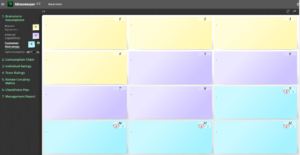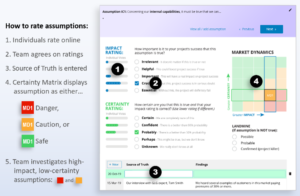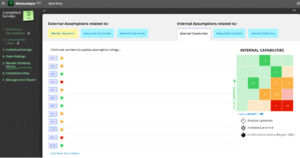Several years ago, the concept of risk assessment was introduced into healthcare. Assessing and managing risk is now a cornerstone to how healthcare organizations need to operate. Have you wondered if there is a way to reduce the risk of not meeting your quality metrics, not achieving accreditation, or not delivering on key internal regulatory initiatives? Have you considered a proven process called ‘de-risking’?
Following your C&A mock survey, you will receive a report that identifies specific areas recommended for improvement, and each of these will have varying degrees of ‘likelihood to harm’ and ‘scope of impact.’ Based on these findings, as you think about internal projects aimed at improving compliance, implementing a facilitated de-risking process can significantly improve your success rate. This process involves:
Effective de-risking will also help in building confidence with your leadership team and the broader organization. Communicating a project plan that incorporates identified risks and mitigation plans will allow everyone to be on the same journey and will enable key decisions to occur more quickly. It will further unify your organization around the common objective of patient, staff, and visitor safety.
There are three steps to effective project de-risking:
First the team generates assumptions that must be true for project success.
Generate assumptions: You and your project team should identify project assumptions. Each assumption should complete this sentence, “For our project to succeed, it must be true that ________.”
Second, the team rates each assumption for likely impact and certainty.
Rate assumptions: Next the team rates each assumption for its likely impact on project success and its current level of certainty.
Third, your goal is to move assumptions from uncertainty to certainty.
Investigate assumptions: Next the team prepares a Checkpoint plan… a series of tasks to better understand each assumption.
After identifying and agreeing on these landmines, every option should be explored to determine whether the certainty of these assumptions can be improved. These assumptions represent failure points for the project’s success.
The proprietary Minesweeper® Software is designed to assist your de-risking process at every step of the way. In step 1, your assumptions are recorded, organized, and sorted electronically in a sticky note format viewable to everyone. In step 2, the software can collect individual scoring of assumptions followed by a graphical representation of the combined view on a Certainty Matrix with each assumption categorized as safe, caution or danger. In step 3, assumption movement on the Certainty Matrix is tracked based on investigative results and mitigation actions taken. Finally, to assist in sharing progress and results with leadership or broader organization, Minesweeper® provides a de-risking report highlighting the following:



During the recent pandemic, healthcare resources were extremely strained and required organizations to become better at prioritizing, managing workload, and making complex decisions without sacrificing patient care. A de-risking approach to project management aimed at patient care can ensure the continued best use of everyone’s time and the best possible outcome. The outlined approach will ensure everyone is working on the right projects, focused on addressing the most critical aspect of each project, and delivering the highest success rate possible. C&A, together with AIM, can help you get started on this process and incorporate this ‘way of thinking’ into your culture.
References
Dan Adams, President of Aim Institute, and creator of Minesweeper® project de-risking methodology used to detect and avoid “landmines” in transformational projects. https://theaiminstitute.com/about-aim/aim-team/dan-adams/
Would you like to try de-risking a critical project on which you are working? We can provide this support following a mock survey, we can help you on an existing project, or we can conduct training, so you are proficient at using this approach anytime. Contact us at 704-573-4535, send us a message, or request a proposal. We look forward to supporting your organization!